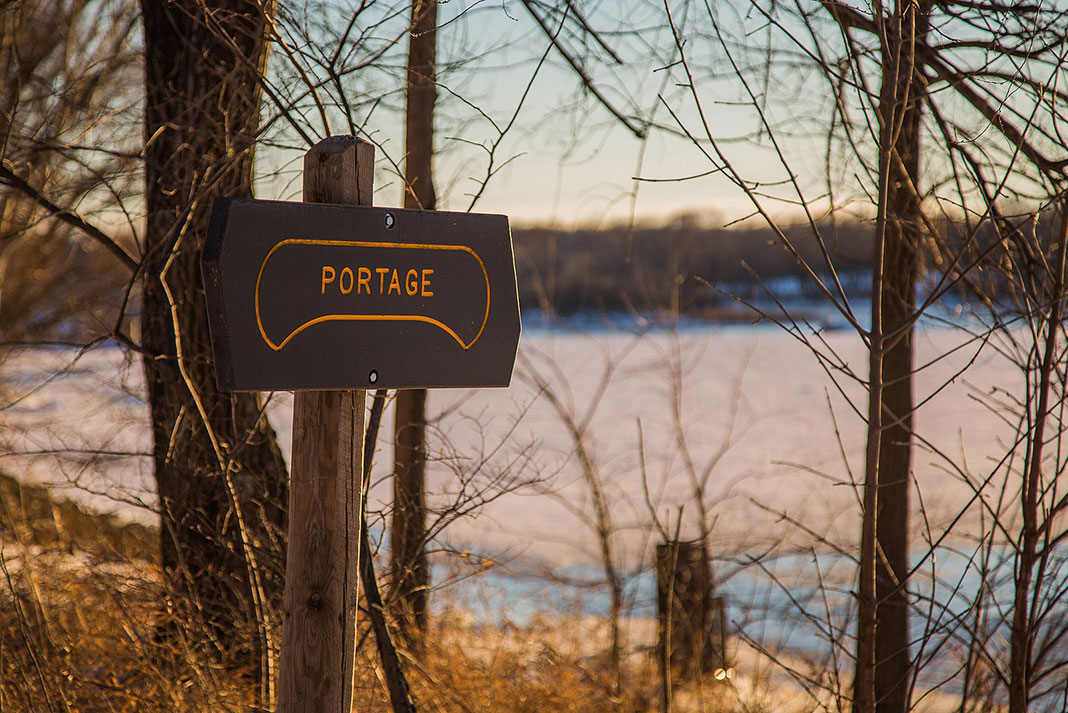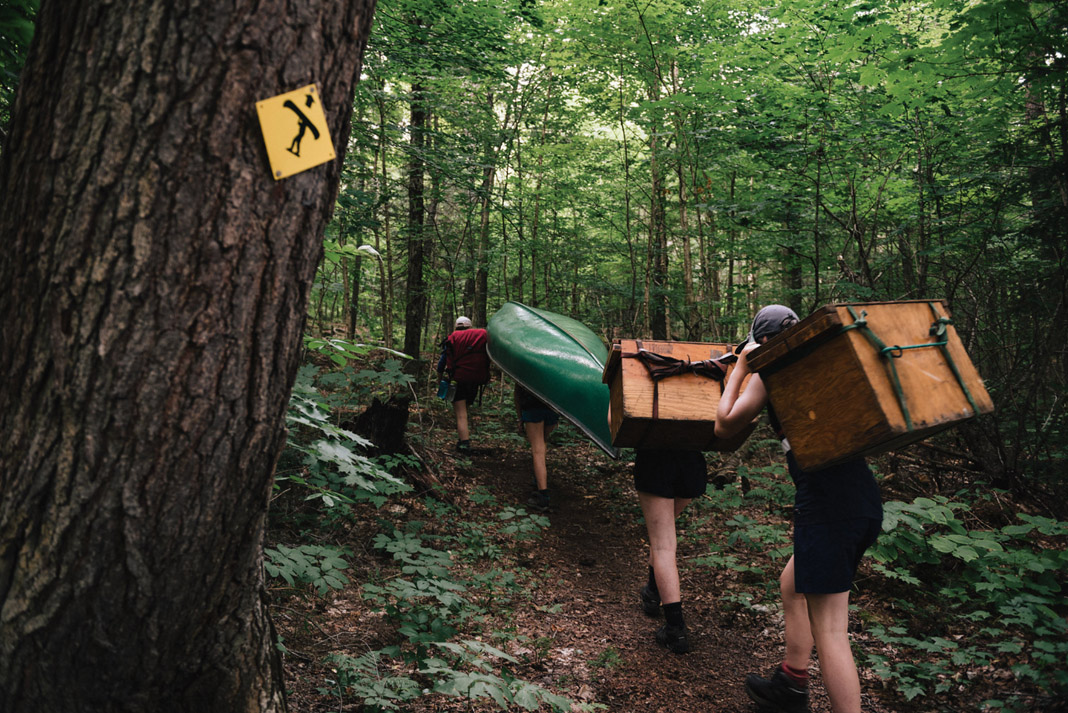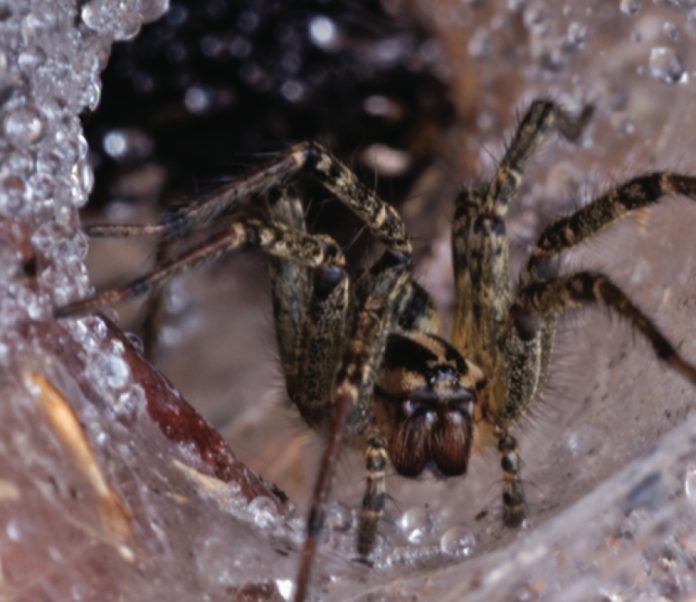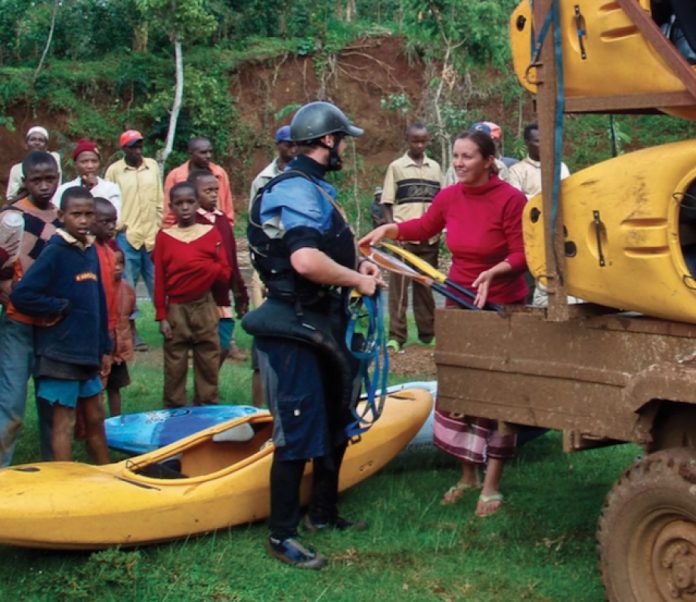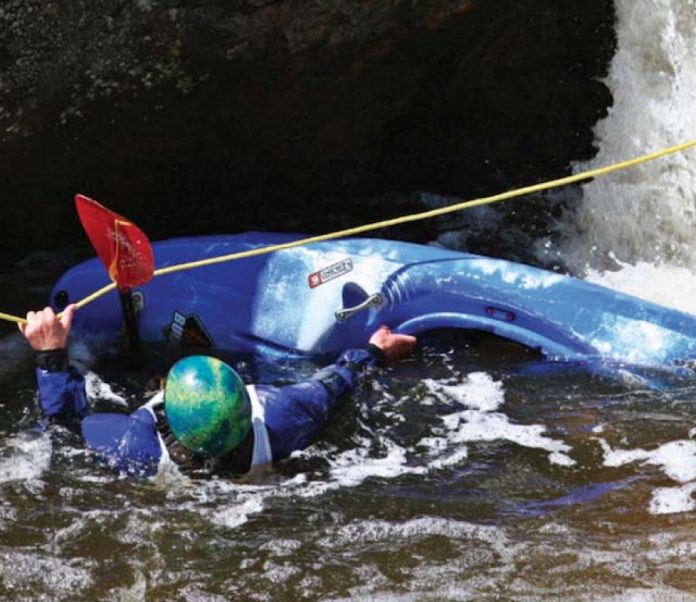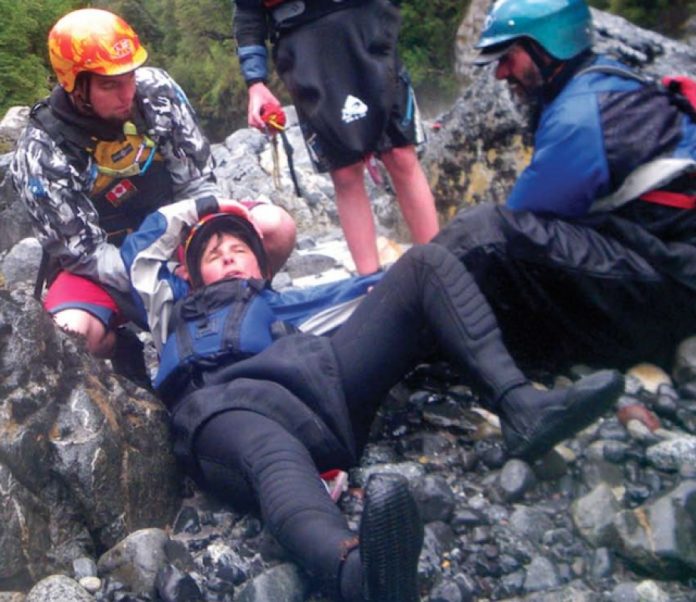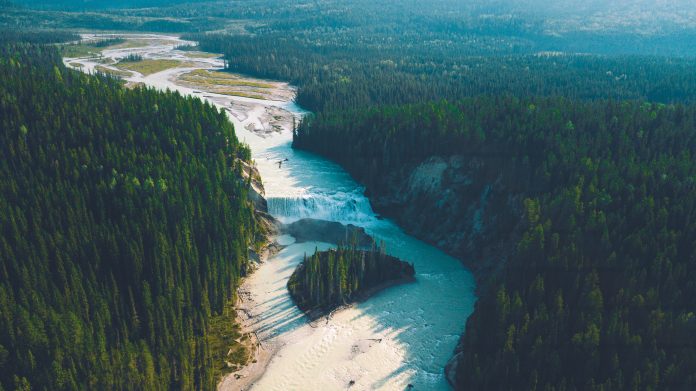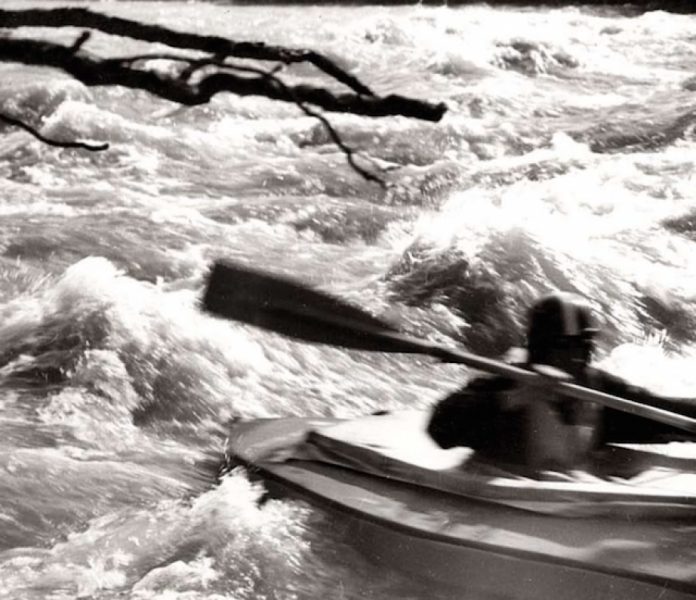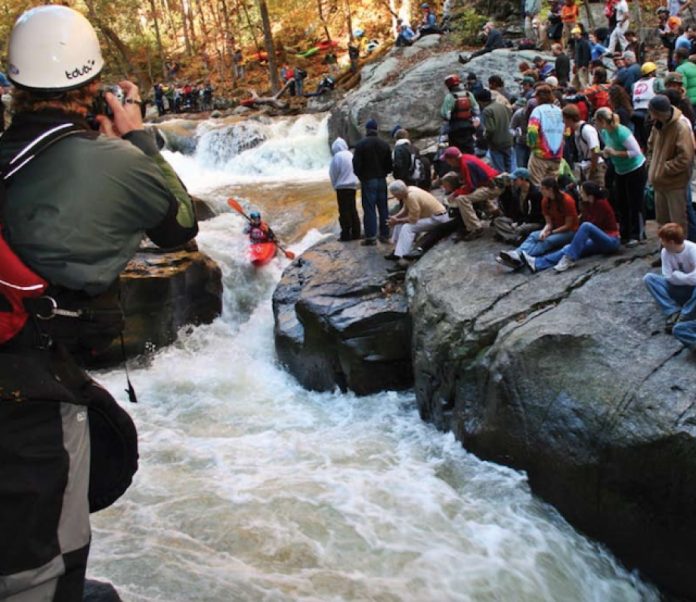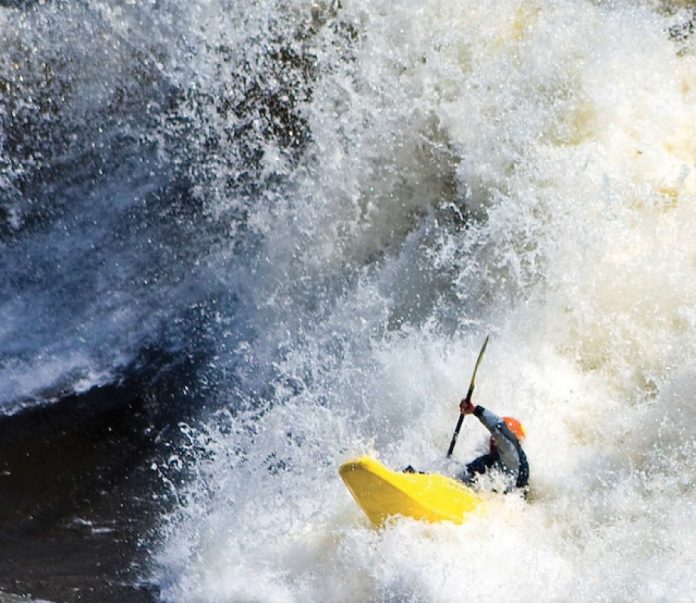Highlights, interviews and crashes at the 15th annual Green Race in North Carolina. We talk to competitors and spectators to find out what makes them come back year after year and they tell us why this event keeps growing.
Why Self-Motivation Is Key To Your Canoe Portage
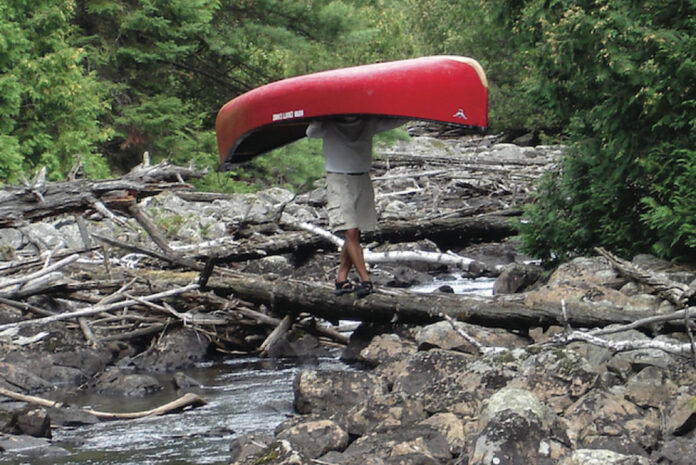
It seemed a moot point to the accused, but I take the act of stealing red Life Savers out of my candy stash very seriously. I toss these sugary rings in my mouth at every 1,000-meter mark along a canoe portage, a personal act of rich reward—and the only thing that seemed to get me to the other side of the particularly grueling, blackfly-infested trails we trudged along on that trip.
My tripmate claimed I was being overly dramatic when I threatened to never travel with him again. He gave me an evil smirk and took my last Life Saver. I haven’t tripped with him since.
Self-motivation is key to your canoe portage

What gets each canoeist to the other side of a portage varies. Some, like me, treat themselves to high-grading their candy bags. Others go into a dreamscape of good first dates, movies worth seeing a second time and dirty tricks to play on their bosses. Some paddlers simply think of things happening back at home—like traffic jams and the Greek economic crisis—to give them reasons why the pain of the portage isn’t so bad.
Many of us hum, or if we know the words, sing monotonous show tunes or the last song we heard on the radio driving to the put-in. The Proclaimers’ I’m Gonna Be (500 Miles) is a favorite. So are Dancing Queen by ABBA, Harry Chapin’s Cat’s in the Cradle and John Denver’s Poems, Prayers and Promises.
I remember a 27-day solo trip when I couldn’t get Aqua’s Barbie Girl out of my head. Imagine “I’m a Barbie girl in a Barbie world / Life in plastic, it’s fantastic / You can brush my hair, undress me everywhere / Imagination, life is your creation” every step of every portage. It was a long month.
With suffering comes the sweetest reward
Where the portage is located on the trip changes the carrot I dangle from my deck plate. In the beginning, I daydream of monster walleye, picturesque campsites and the peaceful solitude I know I’ll find deeper into the interior. Near the end of the trip, it’s the thought of a cold beer and roadside junk food that makes me dance (albeit a slow waltz) my 60-pound canoe barrel across to the other side.
Ultimately, what gets most of us to the other side—no matter when and where—is the fact that the portage, nasty or not, is the only thing that protects the places we’re portaging to.
I almost guarantee that he or she who suffers the most, will be rewarded the most. A two-Life Saver portage with steep inclines and a squishy spruce bog will give you complete solace. There will be no crowds at the end.
If you do stumble across another canoeist—ideally not as you are belting out “Come on, Barbie, let’s go party, ah ah ah, yeah” from beneath your Rob Roy—be assured she’ll be just as in love with the pain and pleasure of portaging as you are.
Kevin Callan eats the red Life Savers last.
 This article originally appeared in the Fall 2010 issue of Canoeroots. Subscribe to Paddling Magazine and get 25 years of digital magazine archives including our legacy titles: Rapid, Adventure Kayak and Canoeroots.
This article originally appeared in the Fall 2010 issue of Canoeroots. Subscribe to Paddling Magazine and get 25 years of digital magazine archives including our legacy titles: Rapid, Adventure Kayak and Canoeroots.
Self-motivation is the key to carrying your canoe farther, easier, on a portage. | Feature photo: David Lee
Betcha Didn’t Know About Spiders
- Ever wonder if this fact is true? In your lifetime, you consume eight spiders while sleeping. According to Discovery Channel’s MythBusters, Adam Savage and Jamie Hyneman, our breathing scares spiders away making this claim a myth.
- Fried tarantula is a delicacy in the town of Skuon, Cambodia. The palm-sized spiders are coated in a mixture of MSG, sugar, salt and garlic, fried in oil and eaten as a snack. Tastes like chicken.
- With eight legs and six joints per leg, spiders have 48 knees. Go ahead, count them!
- A spider the size of an 11-inch dinner plate—the Goliath birdeater tarantula—is found in the rain forests of northeast- ern South America and is the largest spider on Earth.
- Approximately 50 per cent of women and 10 per cent of men have some degree of arachnophobia—a fear of spiders. The 1990s, sci-fi horror film Arachnophobia frightens movie watchers with a deadly arachnid invasion of the small California town, Canaima.
- Orb weaver spiders produce silk with a tensile strength similar to steel. Researchers hope to someday produce enough of it for use in body armour.
- In the award-winning children’s novel Charlotte’s Web, Charlotte’s baby spiderlings climb to the top of a fence post at Zuckerman’s farm and demonstrate a technique called ballooning, where spiders release triangular-shaped, silk threads into the air and are carried away by wind currents. Some spiderlings are able to ride air currents for up to 25 days.
 This article first appeared in the Fall 2010 issue of Canoeroots Magazine. For more great content, subscribe to Canoeroots’ print and digital editions here.
This article first appeared in the Fall 2010 issue of Canoeroots Magazine. For more great content, subscribe to Canoeroots’ print and digital editions here.
Full Immersion: The Inside Story on Guided Whitewater Adventure Travel
The founder of what’s become one of the most successful ecotourism operations in the world admits that he didn’t have an ounce of business sense when he first visited Chile and fell in love with the Futaleufu River in 1985. Chris Spelius, then a Dagger-sponsored rodeo boater who’d just competed in the Los Angeles Summer Olympics, taught kayaking for North Carolina’s Nantahala Outdoor Center and had notched the first descent of the Niagara Gorge, decided that he wanted to spend as much time as possible on the little known rivers of Patagonia. He figured the easiest way to do that was to set up shop as a river guide.
“I started it almost like an experiment,” says Spelius. “I was just curious about whether or not it would work. I would present slide shows on the Fu and it would be the first time people had heard of the place. I was amazed when the phones rang and the next season I was guiding trips.”
The first trips Spelius ran were bro deals in which he charged nominal fees to lead class V American acquaintances on big water runs. After a few years, Spelius realized that if he wanted Expediciones Chile’s books to balance he had to be more inclusive in his programs and exclusive in his prices. Expert-only boating morphed into beginner- and intermediate-friendly river safaris with an emphasis on instruction; whitewater kayaking expanded to rafting, trekking, horseback riding, sea kayaking, climbing, fly-fishing and bird watching; and prices soared.
Without even realizing it, Spelius had cornered the core of the adventure travel and whitewater market: Older, moderately skilled paddlers with more money than time. A market for guided trips to places like Costa Rica, Ecuador and Mexico emerged, appealing to the middle-of- the-curve demographic that’s a far cry from the globetrotting, waterfall-hucking, dirtbag image of paddlesports marketing. Twenty-five years later, Spelius is still living his dream.
GUIDED WHITEWATER AROUND THE WORLD
Today, guided whitewater trips are offered in exotic places like Suriname, Norway, Thailand and Nepal, besides the classic Central and South American destinations that started it all. Prices range from $350 for seven days of class III–IV+ paddling in Ecuador to $11,300 for three months of paddling and cultural immersion in Chile’s Futaleufu River valley.
Trips run the gamut from laid-back programs with the odd day of paddling to intense, every-day-on-the-water tours. For instance, Quebec’s Esprit Rafting, which has organized adventure programs in Mexico since 1995, runs a weeklong whitewater tour of the Sierra Madre for solid class III boaters simultaneously with a primarily land-based adventure tour to appeal to couples. “When each spouse comes back from the day and says, ‘you won’t believe what you missed,’ we know we’re doing our jobs,” says Esprit owner Jim Coffey.
Esprit’s average group size of eight participants is typical for the industry, as is its 30- to 50-year-old demographics. Coffey requires that participants on his whitewater-intensive Mexican Week of Rivers program have intermediate skills, meaning that “they can roll and it’s fairly reliable,” he explains. Esprit also hosts its fair share of expert boaters.
“Often people think that guided trips are about leading a bunch of newbies down the river,” says Coffey. “But that’s not it at all. We give people the basic rundown and then we work our way down a river like any paddling group would. Some of these people wouldn’t necessarily want to be on an organized trip if they had more time to work out the logistics. We often see younger, budget-strapped guys who show up and try to do it on their own, but inevitably they end up just running the popular, local sections of rivers.”
Fifteen members of Calgary’s Paddle Junkies whitewater paddling club were exactly the type of boaters Simon Cow- ard was targeting when he planned a 12-day trip last fall to kenya. Coward, a whitewater instructor and owner of Calgary’s Aquabatics paddle shop and Adventure Trippin’ tour operator, taught many of his kenya expedition mates their first strokes on Alberta rivers. He says travelling abroad was a natural step in their learning progression.“What we’re try- ing to do is improve paddling skills and give people a cool cultural experience as well,” says Coward. “We do trips in countries where I’ve explored in the past. Basically we’re tak- ing the best of what I’ve done over the years and packing it into a two-week trip.”
Coward’s group consisted of paddlers like Barb Cardwell, a regulatory advisor at Esso-Imperial Oil. Cardwell got her start paddling Ontario and Quebec rivers like the Ottawa, Gatineau and Madawaska before she moved west to work in the front offices of the Tar Sands.“I like to have fun but I don’t like to scare the crap out of myself,” she says.“I don’t think the people in our club have the experience to pull off a self-supported trip of that nature at this point, especially on another continent. The most impressive aspect was having every last detail thought of and taken care of for you. The degree of planning put into the trip to make sure we all had an excellent experience was apparent to all of us every day.”
Therein lies the obvious appeal of going guided: Someone else manages the shuttles, language barriers, permits and paperwork—not to mention dealing with com- plex local geographies that may include rain forests, glacier-melt and monsoons. What’s more, guided trips offer boaters some of the best local knowledge around—a real plus when you’re pushing the envelope far from home. When you sign up for a guided trip “you’re hitting the ground running,” says Coward. “you’re getting a lot of instruction and running a bunch of new rivers. Meals are included, accommodations are sorted, and if anything goes awry you’ve got people there who are trained to deal with it.”
BLENDING PADDLING WITH LOCAL CULTURE
The evolution of guided whitewater trips is also marked by a strong emphasis on blending paddling with culture. It’s the reason veteran guides like Spelius have managed to thrive, and why Coward is in high demand to organize trips to Panama and Tibet in the next two years. “The kenya trip was more then just a whitewater trip for me,” says Trevor Zahari- chuk, an electrical engineer and class III boater from Calgary who joined Coward in Kenya.“It was a place I had always wanted to visit, and the trip was set up to allow us to not only experience some of the great rivers but also enjoy other attractions. It would have been a shame to visit there and not experience those things.”
In the remote Mexican village of Jalcomulco, where Esprit trips are based, Coffey insists that even his most whitewater-crazed clients become engaged with locals. He’s created a “micro-philanthropy” program called Hermanos that encourages trip participants to interact and share with villagers who may not reap the full rewards of the tourism investments. “There’s a lot of great paddling, but there’s also an in- credible connection that we’re able to make for people in this small village,” says Coffey.“When our guests get down here they can’t believe the open door policy. There’s a very genuine hospi- tality that’s a far cry from what people read in the newspapers about Mexico.”
It’s an ironic, happy coincidence that the idealistic lifestyle that Spelius dreamed of creating for himself has become a best-selling ecotourism strategy.“These are the types of experienc- es that are so apart from the ‘steer and herd me down the river’ experience that some people expect,” says Coffey. “We think of ourselves as offering guidance and connection. It’s one thing to go to a country and try to work it out on your own; it’s another to go to a place where you immediately have friends and family.”
Conor Mihell is a writer based on Sault Ste Marie, Ontario.
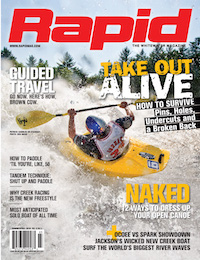 This article first appeared in the Summer/Fall 2010 issue of Rapid Magazine. For more great content, subscribe to Rapid’s print and digital editions here.
This article first appeared in the Summer/Fall 2010 issue of Rapid Magazine. For more great content, subscribe to Rapid’s print and digital editions here.
Survival: Trapped in an Undercut
In May of 2006, Mark Heard—a former Canadian National Slalom Champion and veteran of many difficult and committing expeditions, including B.C.’s Homathko and Dean rivers—lost his life and narrowly got it back on Whistler’s Callaghan Creek. Steve Whittall, a member of Whistler Search and Rescue, had paddled with Heard earlier that day and got the call to evacuate him after the accident.
It was the first day of a weeklong paddling roadtrip. Kayakers from across B.C. and Alberta had travelled to Whistler and were eager to get started. With an afternoon run on the class IV Soo River under our belts, everyone was fired up for a late run on Callaghan Creek.
Timing was tight—a 6 p.m. put-in for a run that takes two to three hours. Callaghan is a class V creek in a deep basalt canyon that has undercut cliff walls and underwater caverns.
I opted out due to other commitments. The paddlers would run the river without local knowledge. A notorious underwater cave at the first rapid had trapped local paddlers before, but never with severe consequences. An easy boof at higher flows, on this low-flow day the 12-foot ledge dropped Heard, 44, onto a boil that surfed him back under the curtain and into the cave.
Unable to roll, Heard exited his boat but couldn’t swim out of the cave. After more than five minutes without air, he floated out of the cave facedown. Ian Norn was watching from an eddy immediately downstream. He clipped onto Heard with his tow system, dragged him to shore and immediately commenced CPR. Two doctors in the pad- dling group helped resuscitate Heard. They shot him with epinephrine and stabilized him as best as possible on the riverbank. The group lit a fire on the snowy ground.
Jean Bourdua hiked out to a logging road and back to his vehicle to call for help on his cell. Having difficulty describing access options to the Provincial Emergency Program (PEP) Coordination Centre and B.C. Ambulance Service, Bourdua suggested they contact me to clarify the location.
I knew that the only viable and timely evacuation from the canyon was via helicopter, but it takes time to get a mission approved by PEP and assemble the necessary manpower, helicopter and equipment. I called Search Manager Brad Sills to mobilize our response.
Within half an hour, we were in the air. In the approaching darkness, the fire proved invaluable for directing the helicopter and serving as a visual reference for the pilot. Heard was secured in an aerial rescue platform, hooked to the long-line and lifted above the tree canopy.
Scott Aitken, a local paddler and Search and Rescue volunteer, was on the end of the line. “[Heard] was thrashing, seizing. Still swimming,” he recalls. “ ‘Just lie down’ I kept saying.” Heard managed to force his arms out of the Velcro strapping of the rescue platform while in the air. “His strength…was [a large] part of his survival,” says Aitken.
Delivered to the Whistler Clinic by 9 p.m., Heard was re-warmed, intubated, stabilized and then heli-evacuated to Vancouver General Hospital.
Four years later, Heard has made a full recovery. He continues to practice as an orthopoedic surgeon in Canmore, Alberta, and still paddles whitewater.
Survival: Shoulder Dislocation on Chile’s Michimahuida River
Chile’s Michimahuida River is a long and committing day run in a steep, isolated valley in northern Patagonia. the glacier-capped mountains through which the river tumbles are volcanic and troubled by frequent eruptions that turn the turquoise waters pasty grey. In 2009, Theresa Landman and her husband Bob Daffe put on the Michimahuida with a party of four other kayakers 10 months after the most recent explosion of volcanic ash and just two days before another eruption. After the group roped down a hillside of mud and ash, an otherwise clean descent turned ugly in the river’s second canyon. Landman explains what went wrong.
I have been whitewater kayaking for 20 years and paddled lots of class IV–V rivers in Chile, Argentina, Africa, Mexico, New Zealand, Ecuador, Nepal, the United States and Canada. Bob had paddled the Michimahuida in 2006.
In the second canyon, I ended up in a chute with many shallow rocks in pushy water and flipped. I tried to roll up but my paddle blade hit a rock as my arm was fully extended. I actually heard a popping sound and wondered if it was my shoulder. I had no choice but to let go of my paddle and work my way out of my kayak with one arm. I started to swim, concerned that I would get swept into the heart of the rapid. I was lucky to wash onto a mid-river rock in a slower section of the rapid.
When Bob arrived, I was clutching my arm across my chest in the telltale position for shoulder dislocation. He set up a rescue on a tether to get me to shore. I wanted to keep my shoulder and arm in the least excruciating position but I had to remove my lifejacket and dry top so Bob could examine the injury. He sent the group ahead to finish the river before dark, leaving just the two of us with a bit of food and spare clothes.
Bob had set dislocated shoulders seven times before and was optimistic mine would go in. I lay as flat as I could on the rocks and Bob placed his foot against the side of my chest and pulled my arm straight. When he applied traction, the pressure and pain eased. After 15 minutes, we heard a distinct click as my shoulder muscles relaxed. Bob gently moved my arm upwards and I felt my shoulder slide back into place. It was instant relief for both of us, despite the fact that we were on our own and a cold, heavy rain had begun.
SEEKING MEDICAL ATTENTION
To progress downriver, I bushwacked through a thick forest of bamboo and Nalga (a giant, Chilean equivalent of Devil’s Club) while Bob paddled the rapids on his own, waiting every 100 metres. Where the river was calmer, I held onto the back of Bob’s boat while he paddled. Eventually, Bob spotted my kayak floating in an eddy. I began paddling easier sections interspersed with difficult portages. At dusk we spotted a cave that became our home for the night. We made a fire to dry our gear and slept in our paddling clothes.
At daybreak, we found the river in flood and the class V rapids impassable. Bob now had to portage two boats over house-sized rocks and around cliffs. Where portaging wasn’t an option, we got back in our boats. I flipped once and tried to roll, but my shoulder was too weak so I went back under and rolled up on my offside. We reached the takeout at 10:30 a.m. to find that our group had initiated a rescue. At the police station they told us that a helicopter was on its way but couldn’t fly due to the bad weather.
I saw a doctor in Chile who made sure the shoulder was back in properly and that there were no other injuries. They put my arm in a sling and gave me some painkillers.
I am now more cautious around holes. To improve my strength and confidence, I exercise my shoulder regularly with a Thera-Band.
SHOULDER DISLOCATION 101
- Shoulder dislocation is the most common acute traumatic injury in kayaking.
- Surgery is required in 13 per cent of acute paddling-related shoulder injuries.
- Reductions should only be performed by trained individuals in the backcountry where evacuation is lengthy and difficult. If a dislocation occurs in the frontcountry, seek treatment at a hospital rather than attempting reduction on the river.
- Following a simple reduction, immobilize shoulder in a sling for five to seven days.
- 95 per cent of all shoulder dislocations are anterior, meaning the head of the humerus (upper arm bone) is pushed forward out of the shoulder socket.
- The U.S. Canoe and Kayak Federation recommends back paddling as an effective exercise for increasing strength and stability of anterior shoulder muscles.
Theresa Landman and Bob Daffe own and operate Tatshenshini Expeditions in the Yukon.
 This article first appeared in the Summer/Fall 2010 issue of Rapid Magazine. For more great content, subscribe to Rapid’s print and digital editions here.
This article first appeared in the Summer/Fall 2010 issue of Rapid Magazine. For more great content, subscribe to Rapid’s print and digital editions here.
Survival: Spinal Injury On The Kicking Horse River
On July 13, 2009, Scott Feindel and three other experienced paddlers kayaked off 98-foot Wapta falls on the Kicking Horse River, a popular tourist attraction inside B.C.’s Yoho National Park. The group hiked in 25 minutes for a preliminary scout, decided the 490-foot-wide drop warranted a closer look and put in 15 minutes upstream. After scouting thoroughly both up- and downstream from both sides of the river, two paddlers ran the falls. Scott Feindel lined up the lip next.
I’ve spent thousands of days on the river instructing, playing, completing as a member of the Canadian Freestyle Team and creeking on day trips, multi-days and expeditions.
That afternoon, I watched Jakub Nemec and Chris McTaggart make first and second ever descents of Wapta Falls. I remember scouting extensively, walking back and getting into my boat. I think I remember seal launching into the water and ferrying out to the lip. After that I don’t remember anything until several days later in the hospital.
THE INCIDENT
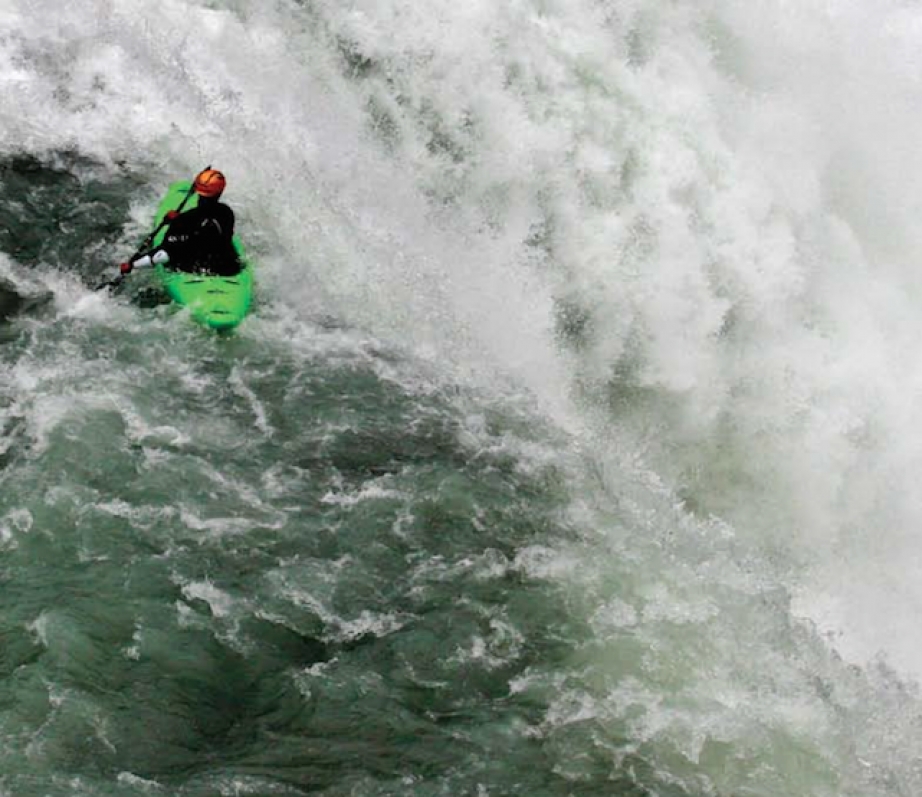
Due to the width of the river, my main concern was being off line. As we had discussed, the team alerted me when I was off, but due to the speed and character of the river, I was unable to get on line. I dropped 70 feet to a rock shelf and was ejected from my boat for the remaining 30 feet. Jacub and Chris pulled me, unconscious, from the class I water below.
I owe my life to the level-headed efforts of all my paddling crew. They alerted rescue using a SPOT GPS messenger and hiked out to a road construction first aid site where Ryan Galleger notified RCMP, then hiked oxygen back in for me.
My friends immobilized me and froze their asses off at the base of the falls for two and a half hours. Marc Ledwidge and Aaron Beardmore from Banff, Yoho and Kootenay National Parks Visitor Safety Program strapped me into a rescue basket that was flown out by Alpine Helicopters pilot Lance Cooper. From the accident site I was airlifted to another helicopter waiting nearby to fly me to Golden Hospital’s emergency room.
THE EXTENT OF THE INJURIES
Once stabilized in the Golden ER, I was transported by STAR’s air ambulance to Calgary’s Foothills Hospital. I spent several days in emergency, four weeks in trauma, and over four weeks in rehabilitation before being granted early release for uncooperative behavior.
I fractured my T12 vertebra, broke 15 other bones, collapsed my right lung and partially collapsed my left, and suffered a severe concussion when my brain collided with the front of my skull.
At first I was wasted on morphine, oxycontin and oxycodone, but the rehabilitation weeks were long. Meanwhile, close friends and family had to deal with the initially unknown extent of my injuries—whether I would be able to walk, and if my long-term mental capacity had been affected. My sister Shannon and good friend David were in emergency when my first purposeful words were a smart-ass remark in David’s ear, which I think alleviated some early stress.
THE EFFECTS OF THE ACCIDENT
I’ve been very fortunate to have a full recovery. The experience has taught me many important life lessons, and that the decisions I make on the river affect the people I care deeply about. I have always felt that the risks and consequences were mine alone to bear, but seeing the stress and heartache that I put my loved ones through, as well as the potential long-term care that might have been needed, I realize this is simply not the case.
I would not have run Wapta if I didn’t feel I had the skill and base of experience to do so safely. I have no regrets, but simply wish to thank those that helped me, and hope that others can learn from my mistakes to safely achieve their goals.
SPINAL INJURY 101
- Broken bones account for nine per sent of acute whitewater paddling injuries and are most common in the back, chest and ankles.
- 33 vertebrae in four regions – cervical, thoracic, lumbar and pelvic – make up the spinal column.
- If a spinal injury is suspected, lay the victim on an even surface on his back and immobilize the cervical spine (C-spine) with a cervical collar or rolled up towel or foam pad.
- Among acute injuries have the longest duration of recovery and effect on paddling.
- Shallow, rocky rapids and significant vertical drops pose high risks for head, neck and back injuries.
Scott Feindel would like to thank his paddling crew, Parks Canada Safety, Alpine and CMH Helicopters, STARS Air Ambulance, RCMP, Ryan Galleger, Golden emergency, the folks at Foothills Hospital and Bodhi Tree Yoga for helping with recovery. Most of all, he thanks his sister Shannon and friends and family for their love and support.
This article first appeared in the Summer/Fall 2010 issue of Rapid Magazine. For more great content, subscribe to Rapid’s print and digital editions here.
Racing’s Big Comeback
For the past couple of years I’ve told anyone who will listen—and many who won’t—that racing is the next big thing in whitewater. There’s some irony in this. In a coming-full-circle kind of way, racing is where whitewater paddling started.
Don’t get me wrong. I’m not talking about the Kevlar, gates and Lycra shorts of the World Cup slalom genre. I’m talking about recreational racing, river running. Jump in whatever you paddle, start at the top and get to the bottom as fast as you can. In North America, this has been going on since the 1940s.
In The River Chasers (Sigel Press, 2001), Susan Taft chronicles the history of whitewater paddling and the development of river running. The earliest North American river running focused on exploration. The 1930s saw descents of most of the great rivers, including the Grand Canyon of the Colorado. Following these conquests, attention quickly turned from exploration to competition. For the next 50 years, from the Appalachian Mountain Club’s first downriver race in 1940 right up to the whitewater kayaking boom of the 1990s, racing was the epoxy that held the sport together.
The granddad of these competitions is Salida, Colorado’s FIBArk downriver race on the Arkansas, run continuously since 1949. In the 1950s, light-years advanced European racers were paid $300 each by race organizers to come to Salida and kick butt. They brought boats, river running skill and fitness as yet unseen.
Roger Paris, Walter Kirschbaum and Erich Seidel—all European champions—upped North American paddling to a whole new level. Legends such as Milo Duffek made extended stays and taught clinics. Paddlers from across the continent converged at FIBArk and went home amazed, armed with new techniques, boat design ideas and courage to push the boundaries. Even today, in the weeks leading up to the June festival, normally eddy-hopping Colorado playboaters can be seen blasting downstream on training runs.
“RACING BECAME A SUB DISCIPLINE OF SLALOM”
Whitewater racing’s first appearance at the 1972 Munich Olympic Games further rallied North American paddling around racing, but the Europeans proved far braver and more skilled on the manmade host course in Augsberg. North American paddlers returned home humbled yet determined to catch up.
It is at this point that racing became Kevlar, gates and Lycra tights. Downriver, or wildwater, racing became a sub discipline of slalom, even though it was the creator of it. Recreational boaters, uninterested in the precision required of slalom, went looking instead for un-run rivers and surf waves. Playboating was born. Where the Olympics were anticipated to be a boon to the sport, they more likely ostracised racing from the mainstream.
Racing as river running is back. With freestyle going the way of slalom as a specialty event, traditional river festivals looking for something new and more paddlers crossing back and forth between mountain biking, triathlons and other fitness sports, the timing is right. River running boats are back in style. Paddlers are revisiting classic runs to beat unofficial fastest times.
The Green River Narrows Race in North Carolina attracts 800 participants and spectators every November. This spring’s Hell or High Water race on the Petawawa River saw 106 racers, a 300 per cent increase in participants over last year. Events like this prove you can have the laidback, social atmosphere of paddling even with a stopwatch at the bottom. It becomes a great reason to get together. That is, after all, where whitewater paddling started.
Jef Jackson is a professor of Outdoor Adventure at Algonquin College in Pembroke, ON.
 This article first appeared in the Summer/Fall 2010 issue of Rapid Magazine. For more great content, subscribe to Rapid’s print and digital editions here.
This article first appeared in the Summer/Fall 2010 issue of Rapid Magazine. For more great content, subscribe to Rapid’s print and digital editions here.
Extreme Creek Racing: Bigger Than Rodeo
Over the past several years, extreme creek racing has exploded in popularity. Where a decade ago a handful of small-scale races catered mostly to dedicated locals, now there are hundreds of races organized for all skill levels. Last year, the Adidas Sickline Extreme Kayak World Championship on Austria’s Oetz River brought together over 100 racers from 22 different countries, proving racing has become a global craze.
“Extreme racing is the way forward,” predicts New Zealand’s Mike Dawson, who took second place at the 2009 Championship. “It’s going to get bigger every year!”
With international corporations like Teva, Red Bull and Adidas hosting televised and tweeted events drawing hundreds of competitors and tens of thousands of spectators, and commanding media coverage that reaches hundreds of thousands of people at home, racing may be the trend that finally pushes kayaking into mainstream sports. At least that’s the hope of ambitious race creators like Adidas Sickline’s globally minded Olaf Obsommer.
WHY RACING IS THRIVING – FOR PARTICIPANTS AND SPECTATORS
So why is racing succeeding as a spectator sport when other kayaking disciplines have struggled? The answer, like racing itself, is simple. Racing is exciting and easy to follow. The first person to cross the finish line, or the competitor with the fastest time, wins. There is no confusing judging or points system as in freestyle. Throw in an element of danger and potential for some carnage and you have a surefire fan favourite, even for non-kayaking spectators.
“Extreme racing is similar to watching a movie,” explains Joel Heath, founder of the Teva Mountain Games. “Even if it is just for a moment, the audi- ence lives vicariously through the boater’s experience and that rush of adrenalin surges through both boater and spectator.”
As racing gets more exposure, sponsorship and hefty cash prizes—up to $5,000 now at some events—are following. This conspicuous end of the racing phenomenon—hard whitewater courses, elite racers, high profile sponsors and the sport and industry observers who follow them—is pushing kayaking forward, but this growth is also a catalyst driving the other, more subtle end of the trend—race-hungry, everyday Joe boaters and burgeoning local racing scenes.
Every year, more grassroots races are popping up on local runs, inviting boaters of all abilities to take up the challenge and join in the fun. The motivations are universal: competition, the promise of an exciting day on the water with friends or the sense of accomplishment in piecing together a perfect run.
If you have yet to experience the thrill of a race, don’t sweat the clock. It’s becoming increasingly easy to find one that suits your skill level. Ask your local club and check out online forums and chat boards. In the United States, the U.S. Whitewater Racing Association brings together a race database and event hosting guidelines.
 This article first appeared in the Summer/Fall 2010 issue of Rapid Magazine. For more great content, subscribe to Rapid’s print and digital editions here.
This article first appeared in the Summer/Fall 2010 issue of Rapid Magazine. For more great content, subscribe to Rapid’s print and digital editions here.
Hunting Monsters: The Quest for the World’s Biggest Wave
River gauges this spring recorded unseasonably low water in the Northeast but that didn’t stop a dedicated band of professional kayakers from launching themselves on a single-minded mission that’s become an annual tradition: the quest for the world’s largest surfable river wave.
Stakeout, as this quest has come to be known, originated in 2000 when Marlow Long and I got our first taste of mammoth waves on the Ottawa’s Bus Eater. This wave was unlike anything we’d ever surfed and we were confident that if we scoured the countryside, we could find more like it. Aided by Google Earth, our expanded search started the following year in Quebec, exploring the high volume rivers that cover this region. We soon discovered many rivers with potential but without adequate flows, and so the wait—and our stakeout—began.
Hunting giant waves requires keeping your eye out for potential, watching levels and hustling to the rivers as they start to spike. Each spring, the monsters awake with the thaw as the banks.
Hot on the trail, our group—an international crew including Ben Marr, Rush Sturges, Steve Fisher, Joel Kowalski and B.C. Boys Logan Grayling, Micah Lyall and brothers Max and Dylan Davidson—piles into sagging RVs and questionable motels along the backroads of Quebec.
The province has rewarded us with some of the world’s best river waves and ample opportunity to progress freestyle kayaking. Giants like Black Mass, Detonator, Sirens, Half Mast, Ginormica, Biggie and Gladiator have been discovered on Stakeout, making the long drives, excessive flat- water, unavoidable bendering and general mayhem that comes with a group this size entirely worthwhile.
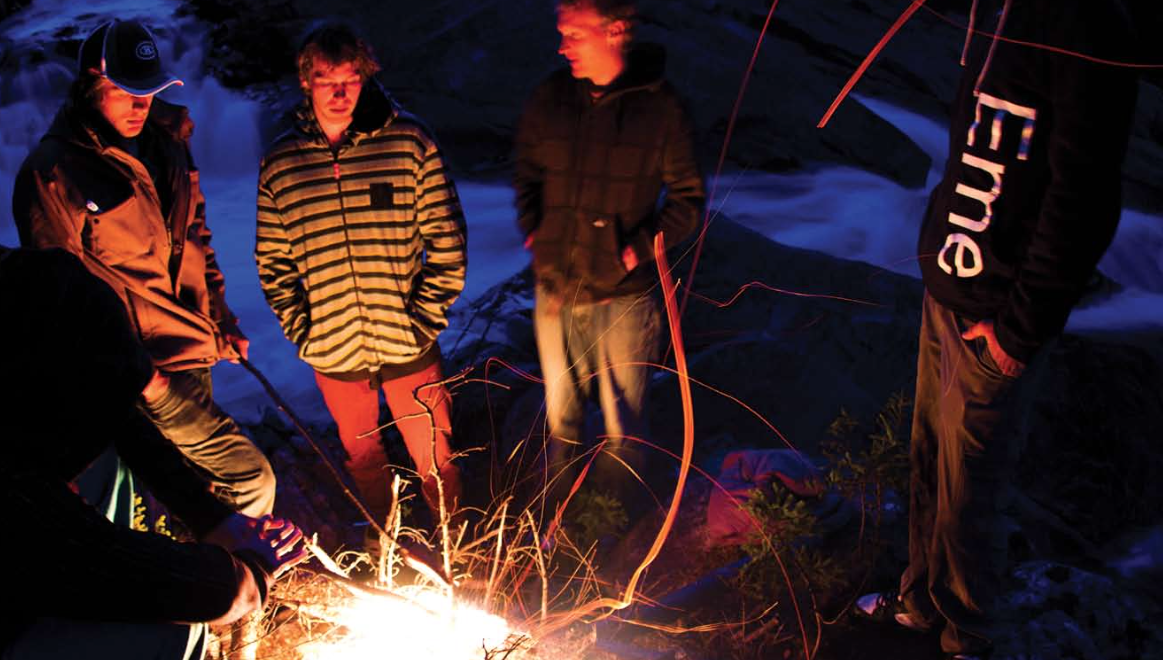
STAKEOUT GOES DOWN UNDER
While the search continues in Quebec, others have taken the cause to more distant lands.
In February, a team led by freestyle icon Anthony Yap headed deep into Western Australia’s isolated Kimberly region during cyclone season on a month-long, self-supported expedition in hopes of finding monsoon-swollen river waves. While the skies stayed clear and the river low during the expedition, the crew remains undaunted.
“The Kimberley has amazing potential,” says Yap. “Huge monsoonal downpours, rapidly fluctuating river levels and some amazing rapid forma- tions have left me convinced that there are epic waves out there—we’ll continue the search until we find them.”
Much of what drives Stakeout and other wave- finding missions is the fact that there are so few known big-river waves suitable for freestyle. Their formation takes a certain unique set of circum- stances. High volume rivers are the best bet for giant waves but adequate gradient and the right riverbed topography are necessary as well. A decade of experience has shown the best waves— those with good shoulders and larger surfable windows—to form off slanted shelves. Fast, unaerated water and some slower water behind the wave to back it up combine at the best spots.
Given all the critical elements in play, there are perhaps only 15 world-class big waves around the globe and most run for only a few short periods throughout the year. So where will the quest for these elusive giants take big wave explorers in the years to come? China and Russia show promise—both have vast areas with high volume rivers as yet untapped for freestyle. And the Stakeout crew has a top-secret list of drainages that should keep the dépanneur Red Bull and diesel flowing for many cold Mays to come.
 This article first appeared in the Summer/Fall 2010 issue of Rapid Magazine. For more great content, subscribe to Rapid’s print and digital editions here.
This article first appeared in the Summer/Fall 2010 issue of Rapid Magazine. For more great content, subscribe to Rapid’s print and digital editions here.



